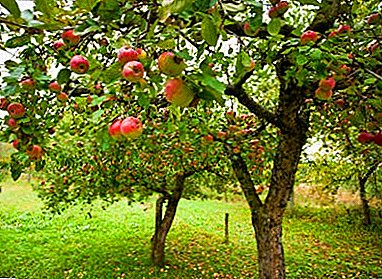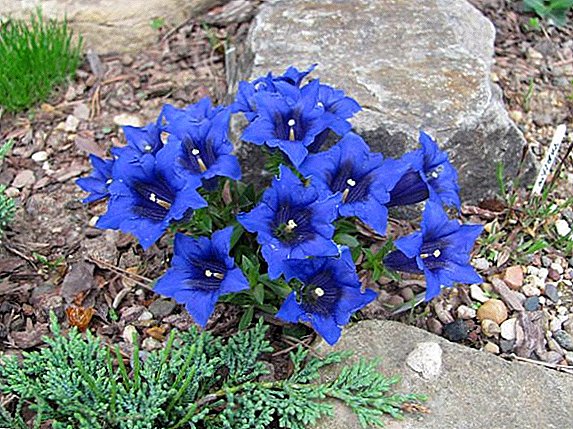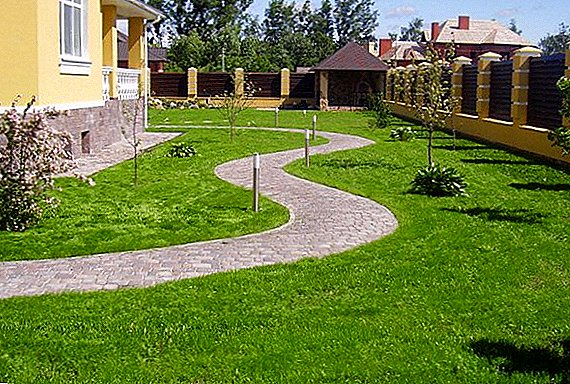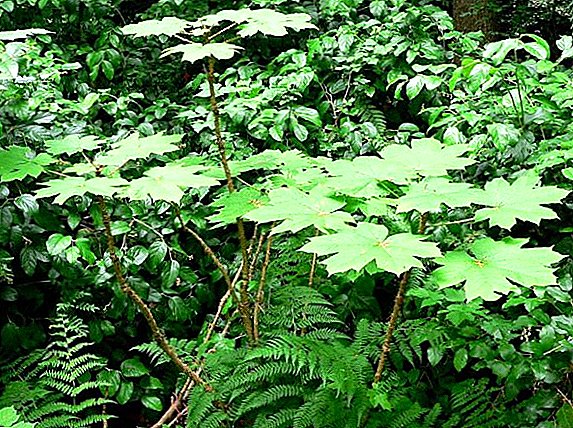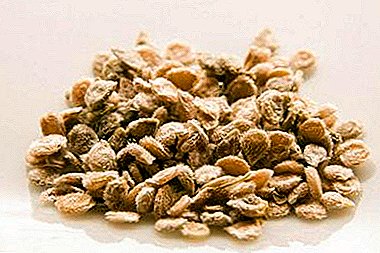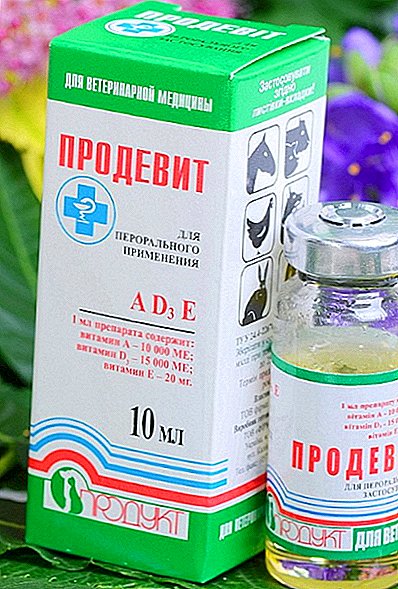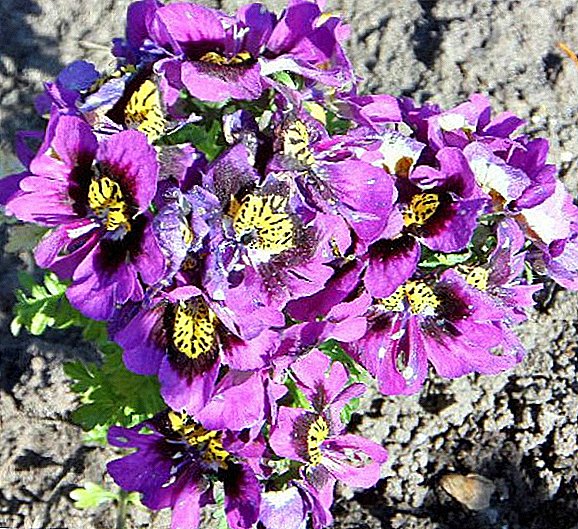 One of the most common varieties for growing in the dacha plots and in farms is the "Lady Fingers" variety. These are elongated fruits that grow in any soil and give a good harvest even on the most common garden bed. Variety refers to the early ripening, which adds to its popularity. Important information for deciding what to grow, what sort to choose, about the characteristics of cultivation and processing are information about the variety and its features.
One of the most common varieties for growing in the dacha plots and in farms is the "Lady Fingers" variety. These are elongated fruits that grow in any soil and give a good harvest even on the most common garden bed. Variety refers to the early ripening, which adds to its popularity. Important information for deciding what to grow, what sort to choose, about the characteristics of cultivation and processing are information about the variety and its features.
Variety description
"Ladies fingers" can be grown in open and closed ground - greenhouses and greenhouses. Tasty fruits of a cylindrical form are used by hostesses in preparations for the winter, salads, in the form of juice and second courses. Can be stored in a cool place for up to 4 months.
The variety is early ripening, therefore fruiting begins in June and lasts until autumn. About 110 days pass from germination to full maturity. One shrub can produce about 1 kg of fruit. In the greenhouse it is possible to produce up to 15 kg of tomatoes per square meter. m (6-8 bushes).
Fruits are elastic, dense, sweet-sour to the taste. During transportation do not deteriorate. Tomato "Lady Fingers" refers to the determinant varieties. Such a variety can reach a height of up to 1 m. As soon as the ovaries form in the upper part of the bush, growth stops.  For this reason, the plant does not need to pinch and form a bush. The lack of determinant varieties can be considered a limited number of floral brushes - 4-6 pieces, with 5-6 tomatoes in each brush.
For this reason, the plant does not need to pinch and form a bush. The lack of determinant varieties can be considered a limited number of floral brushes - 4-6 pieces, with 5-6 tomatoes in each brush.
The advantages of varieties for farms are:
- simultaneous maturation of the crop;
- excellent taste;
- early ripeness;
- resistance to late blight and other diseases;
- good preservation of the fruit.
Get acquainted with the nuances of growing such varieties of early ripe tomatoes like "Samara", "Bokele F1", "Kiss of Geranium", "Caspar", "Aelita Sanka", "Gulliver F1", "Batyana", "Troika", "Irina f1" , "Countryman", "Snowdrop", "Crimson Giant", "Tolstoy f1", "Blagovest", "Miracle of the Earth", "Little Red Riding Hood", "Apparently Invisible."
"Ladies fingers" tolerate frost and drought. The quality of the harvest will depend on the amount of moisture and nutrients the plants receive.  The variety is resistant to diseases. It is practically not affected by late blight, as it matures before the pathogen starts to activate.
The variety is resistant to diseases. It is practically not affected by late blight, as it matures before the pathogen starts to activate.
Did you know? Considered to be a grade "Lady fingers" bred more than 100 years ago and is now one of the 20 most sought-after varieties in home gardens.
Fruit characteristics and yield
Fruits are bright scarlet, elongated cylindrical shape with a slight ribbing, collected in the brush. The taste of the tomato is sweetish and sour. The average fruit weight is 60 g. Some fruits of the “Lady fingers” can reach a weight of 145 g.
The total yield per bush is about 30 fruits. The texture of the fruit is smooth, the skin is thin and edible, the flesh is juicy, aromatic. In the section of the chamber with small seeds, there are not very many seeds inside. 
Selection of seedlings
Seedlings for tomatoes are grown in a room, greenhouse or greenhouse. The age of the “Lady Fingers” seedling at the time of landing in the ground is 50-60 days. A mandatory requirement for seedlings is diving, that is, transplanting plants from boxes into cups in the phase of the first true leaf.
It strengthens the plant and serves as a kind of vaccination against diseases. Unpicked seedlings survive worse, have a weaker stem and root system, and are susceptible to fungal diseases. In addition, the seedlings are hardened by the removal of plants during the day from the room to fresh air.
Proper seedlings have a strong stem, well-developed leaves and resistance to temperature extremes.  It is easily noticeable in the morning: pickled and hardened seedlings please the eye with slender rows with well-developed leaves. When landing in the ground such plants acclimatize within a few hours.
It is easily noticeable in the morning: pickled and hardened seedlings please the eye with slender rows with well-developed leaves. When landing in the ground such plants acclimatize within a few hours.
Do not buy highly elongated plants with fragile melenkimi leaves. If you were growing seedlings on your own and the plants are too long, then when planting, you can lay the roots and part of the trunk in the planting trench. In this case, a grounded trunk will become part of the root system and will additionally strengthen the bush.
Did you know? To grow tomatoes began the ancient Aztecs in the YIII century AD. er and called them "tomato", which meant - "big berry". The word "tomato" comes from the French "pomme d'ore" - Golden Apple.

Soil and fertilizer
The main requirement for the soil - nutrition. If we are talking about personal plots, then, as a rule, their soils are depleted by the long-term cultivation of the same crops and need to be fed. In addition, they dig up the soil in the fall and spring, as the roots of tomatoes need loose soil and do not develop well in solid soils.
For feeding in the trench for planting make:
- nitrogen - 30 g per square meter. m;
- phosphorus - 12 g per square. m;
- potassium - 45 g per square. m
Top dressing is carried out in the growth phase and before flowering. Grow well in alkaline soil. But the soil for tomatoes can have a weak acid reaction. If the soil is acidic, it is necessary to reduce the acidity by adding slaked lime to it.  To check the acidity of the soil, you need to put a spoonful of soil in a container and pour a spoonful of vinegar on it. Stir the mixture, and if air bubbles appear, the soil may be alkaline or neutral (depending on the number of bubbles).
To check the acidity of the soil, you need to put a spoonful of soil in a container and pour a spoonful of vinegar on it. Stir the mixture, and if air bubbles appear, the soil may be alkaline or neutral (depending on the number of bubbles).
We advise you to read about what types of soil exist, how to improve soil fertility, how to independently determine the acidity of the soil at the site, as well as how to deoxidize the soil.
If there is no reaction, the soil is acidic. The disadvantage of acidic soil is the death of beneficial microorganisms in it and the excellent survival rate of fungi, rot and other pathogenic microflora.
To reduce the acidity of the soil can be lime, dolomite flour, chalk, ash. It is advisable to make these components (you can one of them) a few days before planting directly into the trench for seedlings.
Video: how to determine the acidity of the soil For lime, the spread rate will be as follows:
- acid soil - 500 g / sq. m;
- medium acid - 400 g / sq. m;
- slightly acid - 300 g / sq. m
The best predecessors for the tomato "Lady fingers" are carrots, zucchini, parsley, cauliflower, cucumbers. The purpose of crop rotation is the prevention of diseases and the control of pests that affect vegetables.
Find out what to plant after what and how to plan crops correctly.
Growing conditions
Planting in the ground occurs in early May after the cessation of spring frosts. Tomatoes "Ladies Fingers" are placed between rows with a distance of 50 cm between rows and 30 cm between plants in the same row. If you bring humus into the trench for planting, this should be done 5 days before planting, so as not to burn them.  Watering the plants when planting consists in adding 1 bucket of water to 8 plants. Further care will consist of watering, loosening the soil and fertilizing.
Watering the plants when planting consists in adding 1 bucket of water to 8 plants. Further care will consist of watering, loosening the soil and fertilizing.
Water once a week at the rate of 45 l / sq. m. Watering from the beginning of flowering until the end of the growing season is required. To preserve moisture, the soil in the forest zone is loosened 1-2 days after watering.
Tomatoes are very light-loving, so they are planted in well-lit areas. It should be borne in mind that in hot weather, the area under the open sun is watered every 3 days.
Optimum conditions for the growth of "Ladies fingers":
- air temperature - + 23 ... +27 degrees;
- humidity - 60%;
- illumination - a bright sunny place;
- watering - 1 time in 5 days at the rate of about 5 liters per plant;
- loosening - one day after watering;
- top dressing - in the growth phase and in the flowering phase.

Growing from seed to seedlings at home
Do not purchase seeds in random places from market traders. First of all, you can not be sure of the quality of seed. The shops of goods for gardeners provide a wide selection of various seeds with a large and small amount of packaging.
It will be useful for you to read about how to choose the optimal time for planting tomato seedlings, as well as how to germinate and how to plant tomato seeds.
If you grow tomatoes annually, it is best to procure your seeds from the existing crop. For the grade "Ladies Fingers" it is convenient and acceptable, as it is a grade, not a hybrid, and the seed material will not lose in quality.
For seed harvesting, you choose ripe fruit without signs of disease that you like and squeeze the juice along with the seeds into a separate container. When the seed liquid begins to ferment, rinse the seeds, dry and put them in a storage bag before planting. 
Did you know? As part of the space program, tomato seeds visited the International Space Station in 2000, and were then grown in all schools of Canada as part of the Tomatosphere project.
Seed preparation
For disinfection, seeds can be placed in water with a temperature of +50 degrees for 20 minutes. Then spread the wet seeds in a thin layer on the surface for germination and cover with wet gauze or bandage.
The mesh surface is well breathable, and the fibers retain the necessary moisture for the seeds and do not allow it to dry. A good result gives the soaking of seeds in a 1% solution of manganese potassium for 24 hours. The duration of soaking - 2 days. Sow the seeds in a moist soil. If the soil is dry, it must be watered.
Video: preparation of tomato seeds for planting
Content and location
If you grow seedlings, the seeds are planted in special boxes for seedlings. Some plants die after transplantation, so seedlings need to be grown 30% more than necessary. Soil mixture for it you can buy ready-made in the store, and you can cook from peat, sawdust and mullein.
Important! It is impossible to use the soil from the site for seedlings, as it contains pathogens of various diseases, which will adversely affect the survival of plants.
Seed planting process
If the seeds are planted in boxes for seedlings, they are simply brought into the soil in rows and periodically watered. Seeds will germinate on the 7-10th day after planting.  Seedlings are fed up during growth 2 times with a solution of superphosphate, potassium chloride and ammonium nitrate at a dosage of 30 g / 20 g / 20 g per 10 l of water. Landing is carried out on the 50-60th day of growth of tomato seedlings.
Seedlings are fed up during growth 2 times with a solution of superphosphate, potassium chloride and ammonium nitrate at a dosage of 30 g / 20 g / 20 g per 10 l of water. Landing is carried out on the 50-60th day of growth of tomato seedlings.
Seedling care
Light day for seedlings should last 10-12 hours. The lighting should not be one-sided, since in this case the plants will extend towards the light source. Therefore, it is necessary to highlight them with fluorescent lamps, which provide uniform illumination.
Air temperature should be at least +23 ° С. Night temperature should not fall below +17 ° C. Watering is made from watering can 1 time in 5 days. In the phase of the first formed leaf the plants dive into separate cups and carry out the first feeding.
You will probably be interested to read about how and when to properly dive tomatoes after germination.
Before planting in the ground, starting from the 30th day, the plants organize contact with fresh air. To carry tomatoes on the street should be the day, first at lunchtime, and then for a whole day of light.  The purpose of such hardening is the adaptation of tomatoes to natural climatic conditions, strengthening the plant and increasing its resistance to various diseases.
The purpose of such hardening is the adaptation of tomatoes to natural climatic conditions, strengthening the plant and increasing its resistance to various diseases.
Transplanting seedlings to ground
In the ground, "Lady Fingers" land in early May, on the 50-60th day of growth. Planting is carried out in the morning cool hours so that the plant can acclimate better. For planting the plant is removed from the cup along with the ground. Landing is carried out in a small hole at the same depth as it was in the cup.
The exception is extended plants - they are planted at a slight inclination so that the excess part of the stem is planted along with the root system. A landing with a distance between rows of 50 cm and a distance between individual plants in a row of 30-40 cm is considered optimal. On the whole, 1 square meter. m should be about 6-8 plants.
Video: planting tomato seedlings in the ground
Did you know? It does not matter if you are talking to seedlings, but it is strongly advised to iron her. Impact on the top of the plant by hand or another object causes the production of a special growth hormone ethylene, which accelerates the growth of the plant.
Agricultural technology of growing tomato seeds in the open ground
When planting seeds in open ground observe a number of the following rules:
- soil preparation and planting of seeds is carried out in the same way as for seedlings;
- dig up the soil;
- form trenches for planting;
- 2 weeks before planting, if necessary, reduce the acidity of the soil by making chalk or lime;
- apply fertilizer 4-5 days before planting;
- in the southern regions, germinated seeds are introduced into the ground and covered with rows with a film to create optimal conditions for seed germination;
- after emergence of shoots the film is removed.
 In other regions it is better to plant tomatoes in the ground in a seedling manner.
In other regions it is better to plant tomatoes in the ground in a seedling manner.Outdoor conditions
The spring climate is characterized by sudden changes in day and night temperatures, frost on the soil in the morning hours, and cold winds. Greenhouses and greenhouses are used to protect plants from these adverse factors and to obtain early yields of tomatoes.
A greenhouse is a small film cover for plants about 50 cm in height. The task of the greenhouse is to protect plants from extreme temperatures and freezing. If it is planned to grow tomatoes from seeds in the open ground, then it is desirable to protect young plants with a greenhouse.
For this greenhouse set after planting seeds in the ground. Greenhouses are stationary structures for growing plants. A greenhouse maintains temperature better. Modern covering materials for greenhouses allow plants to receive a sufficient amount of light.  If the greenhouse is stationary, then the soil in it is ready, and before the next season it is simply dug up and fertilized. Seeds are planted in a tape way in order to then remove weak plants or seedlings that have risen too thick.
If the greenhouse is stationary, then the soil in it is ready, and before the next season it is simply dug up and fertilized. Seeds are planted in a tape way in order to then remove weak plants or seedlings that have risen too thick.
The process of planting seeds in the ground
In a greenhouse, seeds are planted in April, after the end of spring soil frosts. In the greenhouse planting is carried out in March. This is due to the difference in temperature regimes: the greenhouse is not heated and will not be able to maintain a temperature of +17 ° C at night. And for the greenhouse, maintaining the desired temperature is not a problem.
Important! To prevent fungal diseases, soak the seeds in a 1% solution of manganese potassium for at least 12 hours.Video: sowing tomato seeds in open ground
Watering
In the open ground in the spring a lot of moisture. Therefore, watering tomatoes is carried out 1 time per week. Most often, ground watering is carried out with a hose. Irrigation rate - 40-50 liters of water per square. m soil, ie, 6-8 plants.
Before pouring water into the trench, moisten the ground with a small amount of water. - This will improve absorption. In rainy weather it is not necessary to water. The water temperature during irrigation should not be below +14 ° C. This is due to the fact that warm water is better and faster absorbed from the soil than cold.
We recommend reading about whether it is possible to grow tomatoes without watering, and also how to properly and how often water the tomatoes in the open field and greenhouse.
Soil loosening and weeding
One day after watering, soil is loosened between plants. Purpose of loosening - provide tomato roots with air access.  Depth of processing - 4-8 cm. The soil crust prevents air from penetrating deep into the soil to the roots and can lead to diseases of the root system, deterioration of its development and weak growth of the plant.
Depth of processing - 4-8 cm. The soil crust prevents air from penetrating deep into the soil to the roots and can lead to diseases of the root system, deterioration of its development and weak growth of the plant.
Also, loosening the soil helps fight pests and weeds. Loosening is carried out with the help of a garden hoe or special rippers: forks for garden, electric or mechanical cultivators. Weeding is carried out as weeds appear, and loosening - after rain or watering.
Masking
Masking - This removal of young shoots, which are formed in the axils of the leaves. Harvesting such shoots enhances the growth of fruits and accelerates their ripening. When staving leave the main stem and stalks with the tassels of the fruit. The technique consists in carefully breaking off the stepson with your fingers.
We advise how to properly seed tomatoes in the greenhouse and in the open field.
Video: tomato pasynkovka For Ladies Fingers, pasynkovaya is optional. Increased growth occurs due to the fact that nutrients are sent to the fruit, and not spent on the growth of additional foliage. After pasynkovka tomato should resemble a neat bush with 5-6 brushes of tomatoes.
Garter
The task of tying tomatoes - lighten the weight that should be held by the barrel. "Ladies fingers" belong to low grades with a height of up to 1 meter, so they do not really need a garter.
Find out how and why to tie tomatoes in the open field and polycarbonate greenhouse.
The basis of tying - fixing the plant at the support structure. The design may be horizontal or vertical trellis, a small fence or fence, wooden or metal pegs. The stem of a tomato is tied to a peg. The garter is carried out as the plant grows.  The horizontal trellis consists of a cord or wire stretched between the supporting elements, to which the plant is attached. To such a base is convenient to tie up not only the trunk, but also the brush of the plant. Vertical trellis - this is a garter of tomatoes to the greenhouse ceiling.
The horizontal trellis consists of a cord or wire stretched between the supporting elements, to which the plant is attached. To such a base is convenient to tie up not only the trunk, but also the brush of the plant. Vertical trellis - this is a garter of tomatoes to the greenhouse ceiling.
As the tomato grows, it is tightened on the mount. Installation of the frame around the plant is a more laborious and impractical process, because the installation of structures around a hundred bushes - this is a very long time, and a large consumption of material for the framework will be required, therefore in the greenhouses, tying on the trellis is used, and in private farms - on the trellis or pegs.
Did you know? If tomatoes are not tied up, then the branches will break under the weight of the fruits, and the fruits themselves will become closer to be located to the affected area by fungi and late blight.
Video: Tomato Garter
Top dressing
The first time feeding is carried out 20 days after landing in the ground. Then a month later, during a mass flowering and fruit formation. The most optimal way - it is top dressing ready fertilizers.
The mixture should contain about 5 g of nitrogenous fertilizers, 10 g of potash and 10 g of phosphate. Dry fertilizers are closed in between the rows. Pour them evenly onto moist soil.
Fertilization technique:
- water the tomatoes;
- a day later, when the plants dry out after watering, - fertilize in bulk;
- the next day - loosen the soil;
- perform the next watering as usual - in 5-7 days.

Pests, diseases and prevention
The grade "Lady fingers" is rather steady against diseases both in the greenhouse, and in an open ground. The most common disease for this variety - mosaic. In this disease, diseased leaves are torn off and burned.
The main distributors of tomato diseases are fungi and bacteria. A feature of many diseases is that pathogens can be in the environment in an inactive state and begin to multiply only after the occurrence of suitable conditions.
Familiarize yourself with the methods of controlling diseases and pests of tomatoes.
Among the diseases of this class are the following:
- mosaic - it is a viral disease that is tolerated by aphids. Her symptoms - the appearance of whitish spots on the tomatoes and brown or yellow spots on the leaves. Heavily damaged leaves curl and die. Often affects greenhouse tomatoes. Effective ways to combat the disease does not exist. A special feature of the virus is that determinant tomatoes, including "Lady Fingers", are resistant to the pathogen;
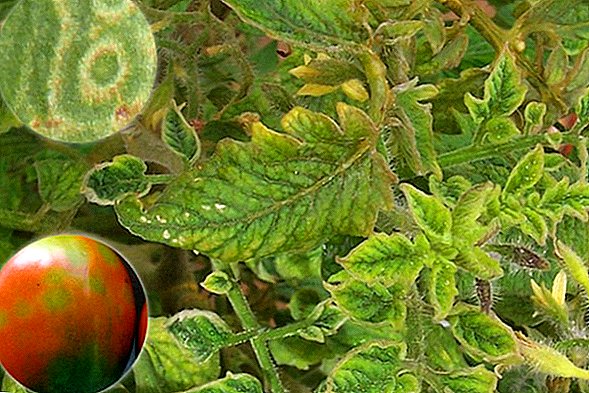
- late blight - this is a defeat of plants after rains by phytophthora fungus. Manifested in the form of brown spots on the leaves and fruits. For prophylaxis use the drug "Fitosporin", and for stopping the disease "Famoxadone" and "Mefenoxam".
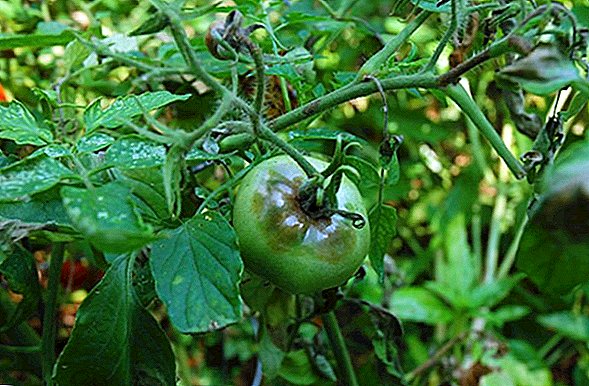
Did you know? Oddly enough, weeds prevent the development of late blight on tomatoes. It is on plants that are among the weeds that blight appears very little.
- black foot, or root rot, appears at the bottom of the plant. Most often found in seedlings. For the prevention of disease, the soil mixture should be disinfected, seeds treated with fungicides, and at the growth stage - Pseudobacterin-2;

- brown spot It is also a fungal disease and appears as light yellow spots. It is treated by spraying fungicides, for example, the drug "Bravo".

All types of fungus begin to develop at high humidity. - after rains or with too much watering. As a preventive measure, spraying with broad-spectrum drugs is carried out, including in the phase of ripening of the crop.
Of the pest insects, the Maybeetle is the most common. It gnaws the roots of the plant, and it dries. Larvae are removed when digging. Gardeners also practice the use of drugs from the bear and other pests. Such drugs are mixed with cereal porridge, for example, buckwheat and laid in the ground.  May beetle When eating porridge insects die. Leaf pests include different types of aphids. To destroy it, use the drug "Proteus". Spraying is carried out in dry windless weather.
May beetle When eating porridge insects die. Leaf pests include different types of aphids. To destroy it, use the drug "Proteus". Spraying is carried out in dry windless weather.  Aphid on tomato leaves If necessary, spraying is repeated after 3-5 days, if the aphid is partially preserved or a new one has appeared. In addition to aphids, tomatoes are affected by whiteflies, shovels, spider mites. Treatment of plants from insecticides is carried out in the form of spraying the drug from a particular type of pest.
Aphid on tomato leaves If necessary, spraying is repeated after 3-5 days, if the aphid is partially preserved or a new one has appeared. In addition to aphids, tomatoes are affected by whiteflies, shovels, spider mites. Treatment of plants from insecticides is carried out in the form of spraying the drug from a particular type of pest.
Harvesting and storage
Tomatoes must be harvested as they ripen. For "Lady Fingers" - it's june - July. Fruits break off from the twigs so as not to damage the shell. If the tomatoes are stored, it is better to remove the stem, so as not to damage other tomatoes during storage.
Healthy intact fruits are placed in boxes. Storage boxes are placed in a dry ventilated area, in which there is no mold. The number of rows in the box should be no more than three, so as not to damage the bottom row of tomatoes.  Ripe fruits can be stored for a long time at a temperature of + 3 ... +5 degrees or those that have been removed from the bush unripe. Ripe stored for about 3 weeks, green tomatoes can lie in boxes for more than a month.
Ripe fruits can be stored for a long time at a temperature of + 3 ... +5 degrees or those that have been removed from the bush unripe. Ripe stored for about 3 weeks, green tomatoes can lie in boxes for more than a month.
Layers of tomatoes in boxes can be shifted with paper or insulating material. Wash the fruit should be only before eating.
Did you know? Tomatoes are used in the manufacture of cosmetics. In perfumery smells of tomatoes and their leaves are used.
Possible problems and recommendations
In order to collect good yields, it is necessary to observe the regime of watering, feeding, as well as airing, if the plants grow in the greenhouse. 
The fall of leaves, ovaries or fruits occurs as a result of a lack or excess of some factor:
- sheet - the main element of photosynthesis. If the illumination is insufficient, then the plant begins to dump unnecessary organs, that is, excess leaves. Therefore, do not plant tomatoes under trees or in other shaded areas. "Lady fingers" - it is a variety particularly sensitive to lack of light;
- the fall of the ovary indicates the lack of trace elements in the soil. For the prevention of such a phenomenon of a plant, it is important to feed in a timely manner before flowering;
- if you see fruits falling, then most likely the plant has become ill with one kind of rot. Rot begins to develop in conditions of excess moisture. Treat the bushes with a solution of copper sulphate, urea and zinc.
Did you know? A sign of high acidity of the soil is a good growth of weeds. At the same time, wheatgrass grows on weakly acidic soil, and woodlice - on sour.

"Ladies fingers" - completely unpretentious variety, which is also excellent fruit without fertilizer. But the quality of your harvest, of course, increases in proportion to the care of plants. Cultivate "Lady Fingers" in open and closed ground and enjoy good yields.
Reviews from the network










